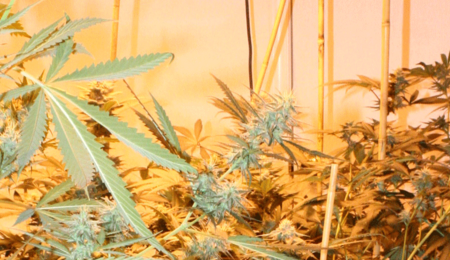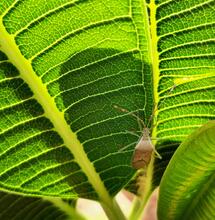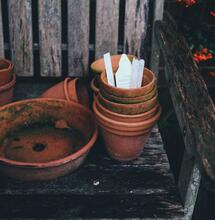Top Tips On Choosing A Grow Light
15 Oct 2018

Replicating the great outdoors, indoors is just the flick of a switch away. Deciding which grow light is best suited for your project can be down to your growing experience, skill level, and financial commitment. Below are my top tips on what to consider, when investing in a grow light.
 This grower will use a HPS for flowering these plants.[/caption]
This grower will use a HPS for flowering these plants.[/caption]
 Here is a very large plant, which has the space to grow huge.[/caption]
My top tip here is using 400w high pressure sodium, will produce small, tight buds, that will not last a grower as long as they would have anticipated. Adding 200w more is a serious difference maker.
Here is a very large plant, which has the space to grow huge.[/caption]
My top tip here is using 400w high pressure sodium, will produce small, tight buds, that will not last a grower as long as they would have anticipated. Adding 200w more is a serious difference maker.
 Calculate your grow space lighting area before planting, to avoid a garden like this.[/caption]
My top tip here is to get an experienced electrician involved, if you are not sure, or to have a backup generator in place, just in case. Avoid causing power cuts especially in residential areas as this will only be a reason for a knock on the door.
Calculate your grow space lighting area before planting, to avoid a garden like this.[/caption]
My top tip here is to get an experienced electrician involved, if you are not sure, or to have a backup generator in place, just in case. Avoid causing power cuts especially in residential areas as this will only be a reason for a knock on the door.
 Intense lighting is the best way to add size to your flowers.[/caption]
Intense lighting is the best way to add size to your flowers.[/caption]
Growing Space
The first thing any person should do before investing in a grow light, reflector, carbon filter, pots or hydro system is work out the actual growing space they have. Once you have calculated that a grow space is for example 1 metre x 1 metre x 2 metres high, you will need to subtract then the area that will be required to hang the carbon filter, reflector, placed oscillating fans inside and then add your pots or hydro system. So a grow space that is 2 metres tall, should allow for 1 metre for the other equipment, by the time the plants have matured. My top tip here is to draw out on a pad, the actual layout from a 2D perspective, outlining how much space each piece of equipment will require. [caption id="attachment_8609" align="alignnone" width="800"] This grower will use a HPS for flowering these plants.[/caption]
This grower will use a HPS for flowering these plants.[/caption]
How Much Power?
Deciding on how much power you need, will dictate the number of lumens, the conversion rate of PAR, the integrity of the lighting spectrum, and the gram to watt ratio that is possible. However, many variables will dictate the overall outcome of a grow. This is not just down the amount of power, yet genetics, skill level, organic or hydro, veg times, seed or clone, as well as the quality of grow light and the spectrum. If you are growing with a CFL, then these are better suited for vegging, mothers and rooting clones. My top tip here is to consider that when it comes to flowering plants, a HPS should be used, with at least 600w of power.Metal Halide
Used for the growing stages, MH lighting is considered old and out of date. As the market focuses on LED and other HPS, the use of metal halides is not seen as practical. Many growers choose to use halide during the vegging stage, then to switch to a HPS for flower. As far as the spectrum is concerned, halides will offer the adequate amount of blue lighting the plants need. My top tip here is to use metal halides for the vegging stage, keeping mothers alive, or rooting a large number of clones.High Pressure Sodium
This is the most common grow light and sometimes the most practical. High-pressure sodium lights (HPS) are available as 250w, 400w and 1000w. To grow plants that have biomass and a good weight, 600W and above should only be considered. [caption id="attachment_8610" align="alignnone" width="800"] Here is a very large plant, which has the space to grow huge.[/caption]
My top tip here is using 400w high pressure sodium, will produce small, tight buds, that will not last a grower as long as they would have anticipated. Adding 200w more is a serious difference maker.
Here is a very large plant, which has the space to grow huge.[/caption]
My top tip here is using 400w high pressure sodium, will produce small, tight buds, that will not last a grower as long as they would have anticipated. Adding 200w more is a serious difference maker.
LED
There has been a shift in the lighting industry, thanks to the breakthrough of LED. With many companies getting away from the cheap Chinese imports and investing in products made in their own countries, the quality and pricing of LED lights have soared over the last few years. During my time using LED, the way these lights are getting better and becoming more practical is only setting a president for the future, conscious green grower. My top tip here is never invest in the Chinese imports, and even though the initial investment is a heavy one, in the long run, you may be happy to be ballast-free, with the electric bills calming down also.Electric Output
As a new grower, or someone who is ambitious enough to take on a sizeable indoor project, knowing your limits as far as power consumption, plays a big part in what lights, carbon filters, fans and systems you can have. Many inexperienced growers can trip their power without even realising, which only results in a timer not kicking in and the whole room remaining in darkness. [caption id="attachment_8611" align="alignnone" width="800"] Calculate your grow space lighting area before planting, to avoid a garden like this.[/caption]
My top tip here is to get an experienced electrician involved, if you are not sure, or to have a backup generator in place, just in case. Avoid causing power cuts especially in residential areas as this will only be a reason for a knock on the door.
Calculate your grow space lighting area before planting, to avoid a garden like this.[/caption]
My top tip here is to get an experienced electrician involved, if you are not sure, or to have a backup generator in place, just in case. Avoid causing power cuts especially in residential areas as this will only be a reason for a knock on the door.
Excess Heat
Once your grow space is entirely equipt, you are now ready to do a temperature test. You will want to aim at a temperature of 24 degrees Celsius, with ventilation and fans blowing. If you leave the grow light on, then after 30 minutes, discover the amount of excess heat the bulb and ballast are giving off. This is technically wasted energy, and if not controlled adequately, it can lead to high temperatures above 24 degrees Celsius, which can then change the amount of humidity that is present in the air. My top tip here is to run your grow lights, carbon filter, and fans before putting any plants inside, for an hour. This will give you a fair reading of if your ventilation is up to scratch. If the temperature and humidity are not in accordance with the growing stage, then try to amend with a higher output of ventilated air or cooling tubes if needed. [caption id="attachment_8612" align="alignnone" width="800"] Intense lighting is the best way to add size to your flowers.[/caption]
Intense lighting is the best way to add size to your flowers.[/caption]



.png)